TABLE OF CONTENTS
2. Game Scenarios
3. Archetypes
GAME SCENARIOS
This time, we will exemplify the principles discussed in the previous article with decisions made during actual matches.
• 1st scenario
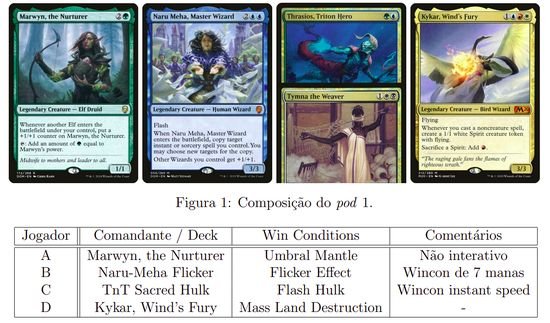
- Player A had a slow development and was trying to gradually create board presence due to decks with mass removals in the match.
- Player B spent the first few rounds managing their hand, trying to gather 7 mana necessary to their win condition while controlling the pace of the other decks.
- Player C tried to gather card advantage in the early game using his commanders. He also used tutors to search for answers and missing pieces for his combo.
- Player D quickly achieved 12 mana with his Dockside Extortionist and was ready to engage in the next turn.
Board state:
A: Some mana dorks, the commander and 1 mana.
B: Commander, some artifacts and 0 mana.
C: Mana dorks, Jace, Wielder of Mysteries (Lab-Jace), commanders and 6 mana.
D: Dockside Extornionist and 12 mana.
In the 5th turn, Player B put a piece of his combo at the top of his library with Mystical Tutor. He used this instant on his own turn because the other players didn't have much mana, although Player C had a Jace, Wielder of Mysteries (Lab-Jace) on the battlefield. Player C then used his Jace, forcing Player B to cast a draw spell at instant speed so as not to lose his combo piece. In response, Player C used Vampiric Tutor to put a piece of his Protean Hulk combo on the top of his library and draw it with Jace. Player C ended his turn with Jace, Wielder of Mysteries, Sylvan Safekeeper and 6 mana.
On Player D's turn (while Player B had no mana), he cast Obliterate, sacrificing his Treasure tokens in order to gather enough mana to play his commander. With the mana generated, Player C cast Flash before switching phases and then wins the match.
- Analysis:
Player B used a tutor to gather his combo piece even though he knew he would need resources to defend it. He also tried to execute his game plan without taking into account his opponents' capabilities, probably because he didn't know much about his decks.
Player D lost the game because he didn't recognize imminent threats from other decks, probably due to a lack of knowledge about the format. He also failed in changing his game plan in the presence of said threats.
• 2nd scenario
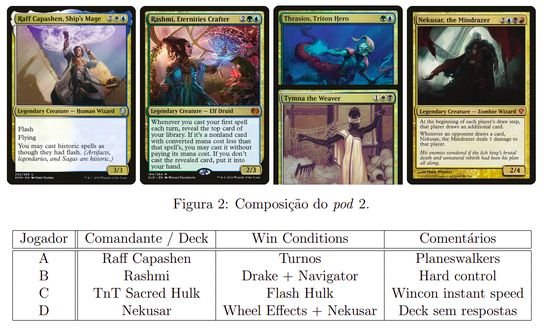
- Player A had a quick development with the help of mana rocks and slowed Player C (which was the fastest deck) with the help of disruptive elements from the other players.
- Player B had a slower development and could not commit to the development of his board due to the threat of Flash + Protean Hulk that Player C presented.
- Player C had a good development with the use of mana dorks and was using the commander to obtain card advantage until he was delayed by a board wipe.
- Player D didn't have permanents that affected the game until his commander was on the field, except for a Howling Mine that was destroyed by Player A (who didn't want others drawing more cards).
Board state:
A: Some mana rocks, Karn, the Great Creator, Teferi, Time Raveler and 12 mana.
B: Commander and 6 mana.
C: Thrasios, Triton Hero, Noble Hierarch, Sylvan Safekeeper and 6 mana. On his hand, he had a Jace, Wielder of Mysteries (Lab-Jace), Demonic Consultation and Veil of Summer.
D: were using a deck with few interactions and so his board and hand did not effectively affect the game.
Player A managed to lead the game with the ability to play at instant speed and due to the acceleration he achieved in the early game, on top of using an off-meta deck, which was mistakenly ignored. With Teferi, Time Raveler preventing other players from finding answers and the ability to develop his board even further on Player D's end-step, it was clear that the game needed to be resolved quickly.
Player B's hand consisted only of a bounce spell, which would not be effective against Player A's Raff Capashen, Ship's Mage, as he could recast his permanents. In the end, Player B spent the turn expecting the worst.
Player C needed Veil of Summer's protection to execute his game plan, but Player A's Teferi, Time Raveler wouldn't let them cast it. So, Player C tried to force Player A's interaction by attacking Teferi with two creatures. Player A blocked one of the creatures but had to cast Teferi's Protection so as not to lose Teferi.
With Player A out of the picture, Player C cast Jace, Wielder of Mysteries and Demonic Consultation. However, Player B had two removals, and so Veil of Summer was not the enough to protect Jace.
On Player A's turn, he cast Knowledge Pool to lock the other players with Teferi. After a board wipe, the other players conceded.
- Analysis:
Player A almost lost the game due to a conservative move and Player B had to use his responses to stop Player C.
Player C tried to end the game early because he didn't think the situation would get any better (and it didn't).
Player D, in addition to not interacting with other players' threats, provided an additional draw with Howling Mine. This kind of strategy can backfire, as giving cards to your opponents isn't the best option.
In short, many resources in this match were misallocated and key decisions were ignored until they could no longer be resolved.
• 3rd scenario
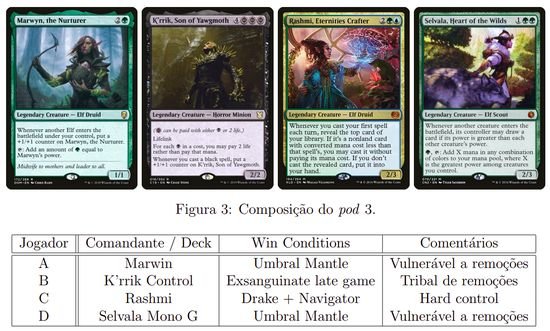
- Player A and Player D both spent the early game trying to use mana dorks to accelerate his strategies, trying to clutch the game quickly with an infinite mana combo, as Player B and Player C would stabilize during the late game.
- Player B and Player C, on the other hand, spent the early game resolving specific threats from Player A and Player D while trying to ramp his mana and gather card advantage.
- After some clashes, Player A and Player D could no longer keep up with the game and so the match would be decided between Player B and Player C.
Board state:
A: Some mana dorks and 0 mana.
B: More than 20 mana.
C: Commander, Counterbalance and more than 10 mana.
D: Mana dorks and 1 mana.
Player B had access to more than 20 mana per turn (thanks to Urborg-Coffers and Mana Doublers) and was expecting a loophole to win with Exsanguinate.
Player C was trying to use Rashmi, Eternities Crafter with Capsize's buyback ability so he could draw even more cards.
Following some stalemate turns, Player C had a Peregrine Drake + Deadeye Navigator combo in hand, but waited until he had more cards than Player B, so he could answer all his removals.
After a few more turns, Player C used Gitaxian Probe to find out if it was possible to outplay Player B's removals. However, Player B had a Sudden Death in hand (a removal with split second).
Player C then cast Brainstorm to put Capsize on top of the deck, which allowed them to use Counterbalance's effect to counter Player B's Sudden Death, as both Sudden Death and Capsize had the same converted mana cost.
After casting Delay, Dispel and triggering Counterbalance, Player C managed to play his Peregrine Drake + Deadeye Navigator combo and proceed to win with Stroke of Genius.
- Analysis:
If Player C was impatient, he would have lost his only combo and possibly the entire match.
However, he identified that it was up to Player B to take initiative and moved aggressively only after being confident that victory could be obtained.
• 4th scenario
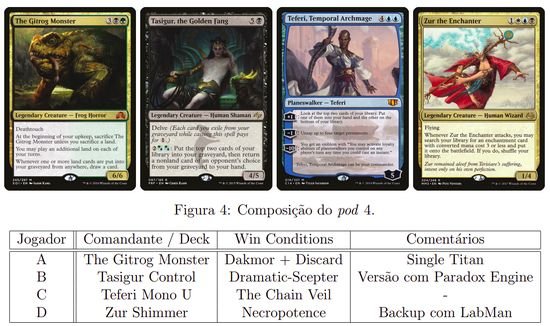
This match can be found in the 1st episode of the 3rd season of Laboratory Maniacs [1].
- Player A had an explosive start with Mana Vault in his 1st turn, an uncounterable The Gitrog Monster in his 2nd turn and a Bazaar of Baghdad shortly after.
- Player B spent the first few turns developing his board and responding to Player A's Gitrog with a Gilded Drake, a solution that was circumvented by Player A using his newly purchased Homeward Path.
- Player C had a slower start and used one of his responses to slow Player D, knowing that Zur is also an explosive deck.
- Player D had one of his acceleration pieces countered but found an opening to try to clutch the game.
After a Timetwister cast by Player C and a Chain of Vapor that cleared much of the field (17:20 in the video [1]), the players used the next cycle to rebuild his boards. After an attempt of a end step sculpt by Player A and a Vampiric Tutor cast by Player D, we have the following:
Board state:
A: Commander, Homeward Path (in the field) and Life from the Loam (in hand).
B: Gilded Drake, Mystic Remora, Exploration, Carpet of Flowers and 3 mana.
C: Grim Monolith, Rhystic Study and 5 mana.
D: Sensei's Divining Top and 5 mana.
Player D then cast a Laboratory Maniac followed by a Demonic Consultation. Although Player B has Mystic Remora and Player C has Rhystic Study (both with enough mana to cast them), Player D thought it was a good time to try to win the game.
The game was starting to get out of reach for Player D, since the other decks had lots of card advantage. The result of the interaction (which was admitted as "greedy" by Player D) can be seen in the episode.
Spoilers, though: Player D was stopped by a simple Chain of Vapor.
- Analysis:
The mistake here was not to ignore the other decks at the table, or even not knowing how to assess threats. Rather, Player D failed in trying to end the game without having any sort of protection against other players' interactions.
• 5th scenario
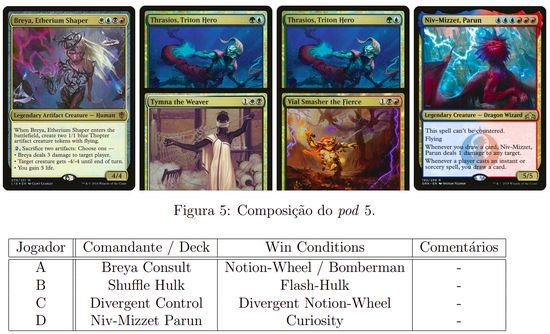
This match can be found in the 2nd episode of the 3rd season of Laboratory Maniacs [2].
- Player A cast in his 1st turn a piece of the Stax strategy (Grafdigger's Cage) that affected two other decks. Then, he spent the next turns only presenting answers.
- Player B cast a mana dork in his 1st turn and Aven Mindcensor in his 2nd (another Stax piece instead of his commander).
- Player C was setback due to the Aven Mindcensor cast by Player B.
- Player D started very slowly and cast another piece of Stax (Cursed Totem) in turn 2.
Board state:
A: Grafdigger's Cage and 3 (blue) mana.
B: Noble Hierarch, Aven Mindcensor and 3 mana.
C: Mox Opal and 1 mana.
D: Cursed Totem, Mox Opal and 0 mana.
Player B had his Tymna the Weaver countered by Player A (12:20 in the video [2]). The battlefield contained 3 pieces of Stax, where 2 of them hijacked Player B's original plan (Flash + Protean Hulk).
- Analysis:
Player B's reasoning was to use the commander as a card advantage engine while he were unable to remove Stax's pieces.
However, Player A thought that in a slower game Tymna would lead in card advantage and surprised Player B with a Counterspell.
• 6th scenario
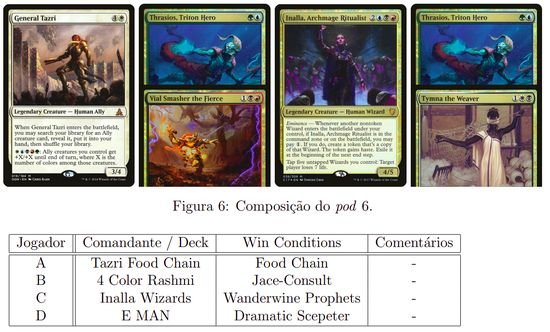
This match can be found in the uncut episode of the 3rd season of Laboratory Maniacs [3].
- Player A had a quick development, as is usual for a Food Chain deck, and spent the first few turns using tutors to gather pieces for his win condition.
- Player B had a slower development, as is customary for a control deck, and used his turns to ramp his mana and cast his commander. The commander choice here is notable as it represents the card advantage he will attempt to establish throughout the game (12:42 in the video [3]).
- Player C spent his early game interacting (stopping Player A's multiple attacks) and casting a Mystic Remora.
- Player D had a slow start and maintained the burden of interaction on Player B and Player C, as he were last on priority (this can be seen by Player D's starting hand at 2:13 [3]).
Board state:
A: Noble Hierarch and 1 mana.
B: Birds of Paradise, Vial Smasher the Fierce and 3 mana.
C: Mystic Remora and 0 mana.
D: Sensei's Divining Top and 1 mana.
In this case, it's worth mentioning the previous moves:
A: Resolved two tutors, had a tutor canceled, cast a Silence and was unable to win the game after a bounce spell on Noble Hierarch.
B: Cast an acceleration piece and the commander, which was tapped before Player A's third turn.
C: Cast a Mystic Remora and only interacted with Player A.
D: Cast a Sensei's Divining Top but had no acceleration pieces or card advantage.
This play didn't directly affect the end of the game, but it would have changed the course of the game if it had been different.
Player B casts a Keen Sense, trying to establish a card advantage engine. Player D casts a Swords to Plowshares on Vial Smasher the Fierce, trying to prevent Player B from developing. The discussion between the players follows (it can be heard at 12:42[3]):
D: I'll cast a Swords to Plowshares, targeting Vial Smasher.
B: Please, reconsider. Luke (A) probably has a Food Chain in his hand. Are you sure you want to do that?
D: Yeah. You still have 3 mana. Cameron (C) has 10 cards and is not that fast a deck. Slow decks win by baiting foolhardy like me into not let them use his engines early and bridging it to the late game. I've lost to Cameron on Tasigur enough to know that, yes, you do, in fact, kick the control player in the first couple turns, otherwise you lose.
B: You are playing a dangerous game.
D: Aha. If I lose to Luke (A), I lose to Luke (A). I can still just lose to you because you have a Keen Sense. I'm not winning in neither of those cases. I don't care who I lose to, I'd rather win.
B: There is a good chance that you might not win because of it.
D: There is a good chance that you should be saving your 3 mana for a counterspell then.
B: What if I don't?
D: Well, then. That's your punt, not mine.
- Analysis:
Player D's reasoning was proven correct, given the outcome of the game.
It is interesting to note that Player B was forced to spend resources to establish a way to unite his early game with his late game.
Player B also acted correctly, as he needed to ensure that his game plan would be executed, even in the presence of Player A's threat.
Overall, great assessment made by Player D on the positions of each player in the match.
Further reading (spoiler) and a centralized PDF (in Portuguese): https://github.com/kaylani2/cedh-ta
REFERENCES
[1] L. Maniacs, “S3 episode 1: Gitrog combo vs tasigur control vs chain veil teferi vs shimmer zur cedh gameplay.” https://www.youtube.com/embed/d5Dlbw0suXo, 2019.
[2] L. Maniacs, “S3 episode 2: Breya consult vs shuffle hulk vs divergent control vs niv-mizzet parun cedh gameplay.” https://www.youtube.com/embed/Xwk0jZIijYI, 2019.
[3] L. Maniacs, “S3 uncut: Food chain tazri vs 4 color rashmi vs inalla wizards vs e man cedh gameplay.” https://www.youtube.com/embed/Hz-hXKlSnxQ, 2019.

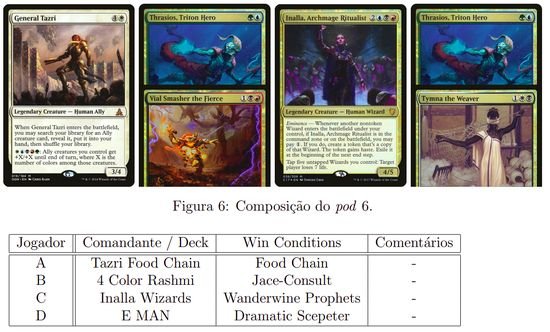






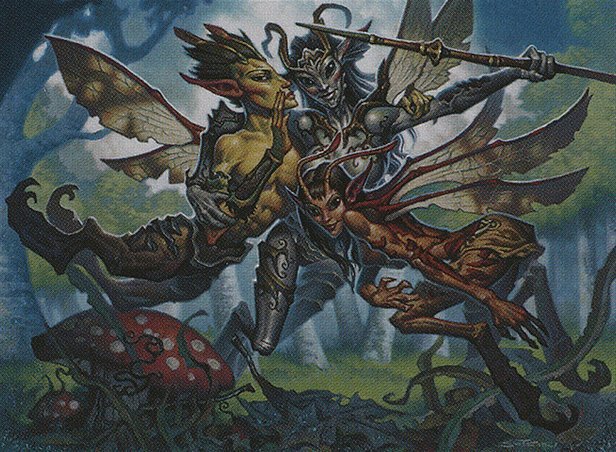
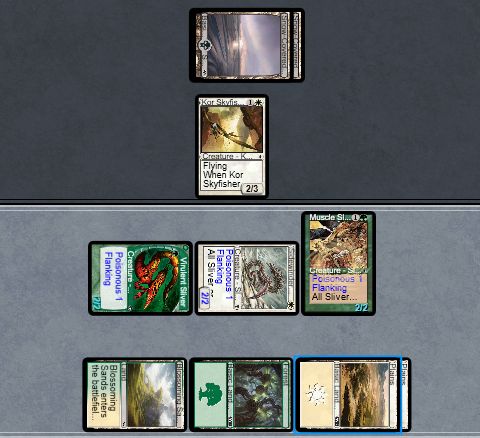



— Comentarios 0
, Reacciones 1
Se el primero en comentar